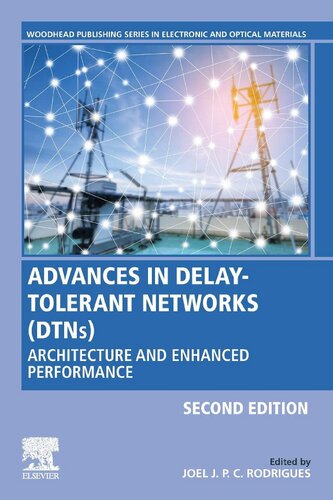Advances in Delay tolerant Networks Dtns Architecture and Enhanced Performance 2nd Edition by Joel Rodrigues ISBN 008102794X 9780081027943
$50.00 Original price was: $50.00.$25.00Current price is: $25.00.
Advances in Delay tolerant Networks Dtns Architecture and Enhanced Performance 2nd Edition by Joel J. P. C. Rodrigues – Ebook PDF Instant Download/Delivery: 008102794X, 978- 0081027943
Full download Advances in Delay tolerant Networks Dtns Architecture and Enhanced Performance 2nd Edition after payment

Product details:
ISBN 10: 008102794X
ISBN 13: 978-0081027943
Author: Joel J. P. C. Rodrigues
Advances in Delay-Tolerant Networks: Architecture and Enhanced Performance, Second Edition provides an important overview of delay-tolerant networks (DTNs) for researchers in electronics, computer engineering, telecommunications and networking for those in academia and R&D in industrial sectors. Part I reviews the technology involved and the prospects for improving performance, including different types of DTN and their applications, such as satellite and deep-space communications and vehicular communications. Part II focuses on how the technology can be further improved, addressing topics, such as data bundling, opportunistic routing, reliable data streaming, and the potential for rapid selection and dissemination of urgent messages.
Opportunistic, delay-tolerant networks address the problem of intermittent connectivity in a network where there are long delays between sending and receiving messages, or there are periods of disconnection.
- Reviews the different types of DTN and shows how they can be applied in satellite and deep-space communications, vehicular communications (including unmanned aerial), and during large-scale disasters
- Considers security concerns for DTN and potential for rapid selection and dissemination of urgent messages
- Reviews the breadth of areas in which DTN is already providing solutions
- Covers the prospects for DTN’s wider adoption and development of standards
Advances in Delay tolerant Networks Dtns Architecture and Enhanced Performance 2nd Table of contents:
1. Introduction to Delay and Disruption Tolerant Networks (DTNs)
- 1.1 Introduction
- 1.2 Delay-Tolerant Network Architecture
- 1.3 DTN Application Scenarios
- 1.4 DTN Routing Protocols
- 1.5 Conclusion
Part One: Types of Delay-Tolerant Networks (DTNs)
2. DTNs for Satellite Communications
- 2.1 Introduction
- 2.2 DTN Architecture
- 2.3 GEO (Geostationary) Constellations
- 2.4 LEO (Low Earth Orbit) Constellations
- 2.5 Conclusion
3. DTNs for Deep-Space Communications
- 3.1 Introduction
- 3.2 Data Communications in Deep Space
- 3.3 Networking Requirements for Deep-Space Data
- 3.4 Implementing a Deep-Space DTN Solution
- 3.5 Summary
4. Vehicular Delay-Tolerant Networks
- 4.1 Introduction
- 4.2 Vehicular Network Applications
- 4.3 Vehicular Communications
- 4.4 Vehicular Delay-Tolerant Networks
- 4.5 Conclusion
5. DTNs for Underwater Communications
- 5.1 Introduction
- 5.2 Related Work
- 5.3 Contemporary View of Underwater DTNs
- 5.4 Future Trends
- 5.5 Conclusion
6. DTNs for Emergency Communications
- 6.1 Introduction
- 6.2 Overview of Proposed DTN Solutions
- 6.3 Mobility Models for Emergency DTNs
- 6.4 DistressNet
- 6.5 Routing Protocols for Emergency DTNs
- 6.6 Minimizing Energy Consumption in Emergency DTNs
- 6.7 Conclusions and Future Trends
7. Green Data Broadcasting in DTNs
- 7.1 Introduction
- 7.2 Energy Efficiency in OppNets (Opportunistic Networks)
- 7.3 Related Work
- 7.4 Green Data Broadcasting Techniques
- 7.5 Evaluation
- 7.6 Conclusion
Part Two: Improving the Performance of Delay-Tolerant Networks (DTNs)
8. Assessing the Bundle Protocol (BP) and Alternatives
- 8.1 Introduction
- 8.2 DTN Architecture and BP Profiles
- 8.3 Alternative Approaches
- 8.4 Future Trends
- 8.5 Further Information
9. Opportunistic Routing in Mobile Ad Hoc DTNs
- 9.1 Introduction
- 9.2 Challenges
- 9.3 Overview of Existing Routing Protocols
- 9.4 Combining On-demand Routing Protocols
- 9.5 Open Research Topics and Future Trends
- 9.6 Further Information
10. Reliable Data Streaming over DTNs
- 10.1 Introduction
- 10.2 Challenges in Streaming Support
- 10.3 On-the-Fly Coding for Robust Streaming
- 10.4 Evaluation of Streaming Proposals
- 10.5 Implementation Discussion
- 10.6 Conclusion
11. Rapid Selection and Dissemination of Urgent Messages
- 11.1 Introduction
- 11.2 One-to-Many Communication in Resource-Constrained Environments
- 11.3 Random Walk Gossip (RWG)
- 11.4 RWG and Message Differentiation
- 11.5 Evaluation with Vehicular Mobility Models
- 11.6 Discussion
12. Social Network Analysis (SNA) in DTNs
- 12.1 Introduction
- 12.2 Social Characteristics of DTNs
- 12.3 Social-Based Human Mobility Models
- 12.4 Socially Aware Data Forwarding
- 12.5 Conclusion
13. Performance Issues and Design Choices in DTN Algorithms
- 13.1 Introduction
- 13.2 Performance Metrics
- 13.3 Processing Overhead
- 13.4 I/O Performance and the Curse of Copying
- 13.5 Throughput, Latency, and Queueing
- 13.6 Discovery Latency and Energy Issues
- 13.7 Conclusions
14. Emulation to Validate Applications on Opportunistic Networks
- 14.1 Introduction
- 14.2 Development Challenges
- 14.3 Requirements for Emulation
- 14.4 Conclusions
15. The Quest for a Killer App for DTNs
- 15.1 Introduction
- 15.2 DTNs as an Enabling Technology
- 15.3 The Quest for a Problem
- 15.4 Conclusions and Future Trends
- 15.5 Further Information
Key Focus Areas:
- DTN Applications: DTNs are used in environments where traditional networks fail due to delays, disruption, or lack of connectivity. Applications span satellite communications, deep-space exploration, vehicular communication systems, emergency response, and underwater communication systems.
- Routing and Protocols: Many chapters focus on specific protocols, such as the Bundle Protocol, and discuss how data is routed in challenging environments.
- Challenges and Innovations: The topics cover practical issues in DTNs, such as energy efficiency, reliable data streaming, opportunistic routing, and performance optimizations.
- Social and Environmental Considerations: There are chapters dedicated to social network analysis in DTNs and green data broadcasting, highlighting the growing importance of sustainability and social factors in network design.
People also search for Advances in Delay tolerant Networks Dtns Architecture and Enhanced Performance 2nd:
advances in dementia treatment
advances in treatment of frontotemporal dementia
generalized developmental delay
reduced delayed hypersensitivity
hypersensitivity in dementia
Tags:
Joel Rodrigues,Advances,Delay,tolerant,Networks,Architecture,Enhanced,Performance 2nd
You may also like…
History - American Studies
Architecture Media and Memory Facing Complexity in Post 9 11 New York Joel Mckim
Engineering - Environmental
Engineering
Advances and Challenges in Structural Engineering Hugo Rodrigues 3030019322 9783030019327
Engineering - Chemical Engineering
Business & Economics
Politics & Philosophy - General & Miscellaneous Philosophy
Philosophy Made Slightly Less Difficult 2nd Edition Garrett J. Deweese & J. P. Moreland
Computers - Networking
e-Health Systems. Theory, Advances and Technical Applications 1st Edition Joel J.P.C. Rodrigues












